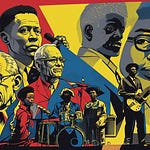Greetings Reggaeology Family,
As the global music landscape continues to evolve, Dancehall’s presence in the mainstream has seen an undeniable steady decline.
Despite its global cultural significance, the genre seems to be losing its foothold on the international mainstream stage, and we keep asking ourselves "What’s causing this shift, and how can we bridge the gap to ensure Dancehall remains a dominant force in global music?"
The story of Dancehall is not merely about music.
It's a narrative of cultural preservation, linguistic identity, and the delicate balance between authenticity and accessibility.
Once a thunderous global force that brought Jamaica's heartbeat to dance floors worldwide, the soundscape now finds itself at a philosophical crossroads.
Some of Jamaica’s biggest international hits—from Bob Marley and Toots to Shabba Ranks, Shaggy, and Sean Paul—were delivered in Jamaican Creole rather than deep Patwa.
This linguistic accessibility played a crucial role in their global success. It's a living, breathing expression of history, resistance, and identity. Yet, in the pursuit of global recognition, language becomes both a bridge and a barrier.
While Patwa is at the heart of Jamaica’s identity, its complexity often alienates non-Jamaican listeners.
Without comprehension, there’s no connection, and the connection is one of the key ingredients in achieving mainstream musical resonance.
Artists like Bob Marley and Sean Paul demonstrated the magical alchemy of making local sounds universally resonant.
They didn't dilute their cultural essence but strategically translated it, allowing listeners from Tokyo to Toronto to feel the music's core emotion.
For Modern Dancehall's current iteration of artists to have equal or greater resonance they must first attempt to break the diasporaic bubble with musical themes that resonate with a global audience.
In their current nesting, these artists have become increasingly introspective and locally focused, limiting their ability to connect with a mainstream international audience with the gravity of their predecessors who sang songs about love, struggle, resilience, and celebration that still have universal appeal.
Trap Dancehall, a blend of Dancehall lyricism with crudely adapted Trap beats, created a sonic tangent that further distanced the soundscape from mainstream recognition.
While it captivated Jamaica’s youth, it struggles to gain traction on the global stage with a buying audience.
However this isn't a story of decline, but one of impeded transformation.
Every musical genre encounters moments of reinvention, where its very survival depends on understanding its core identity to remain adaptable while preserving cultural authenticity in crafting messages that transcend ever-evolving socio-cultural borders.
Now people and pundits constantly ponder; how will Dancehall reclaim its place in the global music scene?
The musical landscape has transformed dramatically.
But today's Dancehall artists face a more complex challenge: how to maintain linguistic integrity while creating global conversations.
Afrobeats, a genre with rhythmic similarities to Dancehall, perfected the balance between authenticity and accessibility, leading to its worldwide rise.
Without a cohesive sonic identity, Dancehall risks being overshadowed by more polished and strategically marketed "alternatives".
Today's "seasoned" producers in the burgeoning Dancehall scene have leaned toward international trends, adding to the dilution of Dancehall’s signature sound in the pursuit of chasing pepper lights.
While there have been standout moments far and few, the soundscape has lacked a unified push to reassert itself as a global powerhouse in the wake of Afrobeat's prominence.
Afrobeats has risen with polished global appeal and memorable collaborations, while Dancehall seems caught between innovation, generational transitions and creative isolation.
Though digital audio workstations have revolutionized production, offering unprecedented creative possibilities, Dancehall has struggled to reclaim its place at the forefront of music culture innovation.
Admittedly, Dancehall's tightrope has always been trying to balance the urge to be a voice for Jamaica's streets while speaking a language that transcends geographical boundaries.
But if we recognise this as an equilibrium rather than an obstacle, the path forward wouldn't be about compromising cultural richness, but strategic translation and musical innovation.
The road ahead requires homegrown Dancehall artists and producers to see their music as a dialogue, not just a performance. A dialogue that honours roots while extending branches to new listeners, new experiences, and new understandings.
Artists need to find a balance between Patwa and English to make lyrics more accessible to global listeners.
Thematically, Dancehall music creatives must explore universal topics while maintaining the soundscape's signature energy, and Producers need to modernize their sound while preserving Dancehall’s core riddim-driven essence.
In many ways, Dancehall's current journey mirrors broader cultural experiences in our globalized world..Dancehall’s essence remains powerful, but its global positioning requires recalibration.
By striking the right balance between authenticity and accessibility, the genre can once again find its well-awaited return to the global mainstream.












Share this post